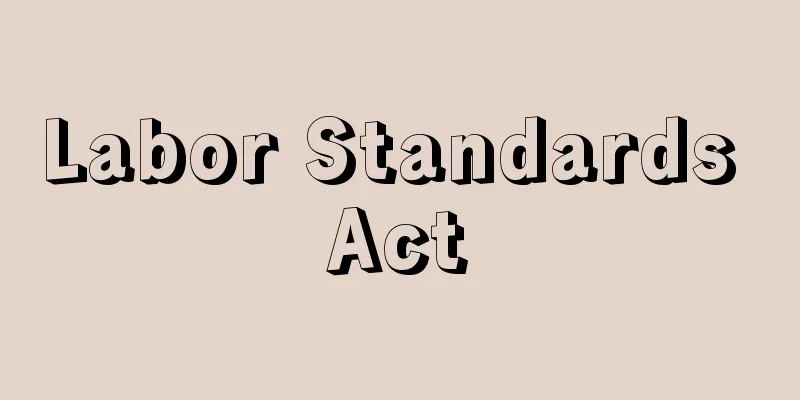Labor Standards Act

|
This law, which established mandatory minimum standards for working conditions, was enacted in 1947 under the basic principle of guaranteeing the right to live for workers. It was enacted in 1947 under the Act No. 49. It is abbreviated as the Labor Standards Act. The field of law in which the state directly intervenes in employment relations and seeks to protect workers by enacting minimum standards for working conditions is called labor protection law (or worker protection law). Specifically, there are various laws such as the Minimum Wage Law (Act No. 137 of 1959), the Industrial Safety and Health Law (Act No. 57 of 1972), and the Workmen's Accident Compensation Insurance Law (Act No. 50 of 1947), and this law is considered to be the basic law. Along with the Labor Union Law (Act No. 174 of 1949) and the Labor Contract Law (Act No. 128 of 2007), this is an important law that forms the core of Japan's labor legislation. [Michio Tsuchida and Yuki Okamura, November 19, 2018] HistoryIn a capitalist society, employers (capitalists) and workers are formally equal contracting parties and are expected to agree on working conditions such as wages and working hours (principle of freedom of contract). However, workers are forced to earn the majority of their living expenses through their own labor, and are in effect in an economically inferior position to their employers. In this situation, if formal freedom of contract were to be enforced, problems would arise in which economically superior employers would force poor working conditions on workers. Therefore, in order to protect workers, various labor protection laws that set standards for working conditions have been enacted, starting with the British Factory Act of 1802. In Japan, the Factory Act was enacted in 1911 (Meiji 44) and came into force in 1916 (Taisho 5), but the level of regulation was extremely low and, due to the lack of an effective supervisory body, it was virtually ineffective and was practically a dead letter. The introduction of full-scale labor protection laws had to wait until the enactment of the Japanese Constitution and the Labor Standards Act after World War II. [Michio Tsuchida and Yuki Okamura, November 19, 2018] Basic PhilosophyThe Labor Standards Act was enacted in April 1947 based on the Constitution of Japan, with the basic principle that the state should directly intervene in contractual relationships and guarantee workers' right to life. Article 27, paragraph 2 of the Constitution of Japan states that "Standards relating to wages, working hours, rest, and other working conditions shall be determined by law," making it clear that the state should directly intervene in labor contract relationships through the enactment of laws (amendment of the principle of freedom of contract). At the same time, the Constitution of Japan proclaims the guarantee of the right to life, stating that "All people shall have the right to maintain the minimum standards of wholesome and cultured living" (Article 25, paragraph 1). Based on these constitutional provisions, the Labor Standards Act stipulates that "Working conditions shall be such that workers are able to live a life worthy of human beings" (Article 1, paragraph 1), making it clear that the guarantee of the right to life is the basic principle, and sets mandatory minimum standards for working conditions (contents of labor contracts) in each provision. [Michio Tsuchida and Yuki Okamura, November 19, 2018] ContentsThe Labor Standards Act consists of 13 chapters and contains various provisions regarding standards for working conditions and the protection of workers' human rights. Chapter 1 (Articles 1-12) is the general provisions, which stipulate the rules common to the entire Act. Of these, Articles 1-7 (principles of working conditions, determination of working conditions, equal treatment, principle of equal pay for men and women, prohibition of forced labor, elimination of intermediary exploitation, guarantee of exercise of civil rights) are called the "Labor Charter" and are particularly important provisions in that they aim to protect the human rights of workers. Similar provisions can also be found in Chapter 2, etc. (prohibition of anticipatory compensation: Article 16, prohibition of offsetting advances: Article 17, prohibition of forced savings: Article 18, etc.). Next, Articles 9 and 10 define the scope of application of this Act by providing definitions of "worker" and "employer," and Article 11 provides a definition of "wages" that are covered by this Act. Chapter 2 (Articles 13-23) contains various provisions regarding labor contracts. Specifically, it stipulates the effect of contracts that violate this law (Article 13), the upper limit of the contract period (Article 14), the obligation to clearly state working conditions (Article 15), the prohibition of the aforementioned compensation schedule, offset of advance loans, and forced savings (Articles 16-18), and procedural restrictions on dismissal (Articles 19-21). Of these, the provisions of Article 13 are particularly important. Historically, the effectiveness of the Labor Protection Law has been guaranteed mainly by public law regulations such as the application of criminal laws and administrative guidance. In contrast, Article 13 stipulates that contracts that violate this law are invalid, and the invalid parts are to be supplemented according to the standards stipulated by this law. This means that the Labor Protection Law is given the effect of private law, which directly regulates the content of contracts, and can be said to have established stronger measures to ensure effectiveness compared to traditional public law regulations. Chapter 3 (Articles 24 to 31) contains provisions related to wages. In particular, Article 24, which stipulates the principles of wage payment, including the principle of payment in cash, the principle of direct payment, the principle of full payment, and the principle of payment on a fixed date at least once a month, is important. Since wages are an important source of income for workers, this law aims to ensure that workers receive their wages through these principles. This Act also contained provisions regarding minimum wage standards (minimum wages), but these have now been separated and developed into the Minimum Wage Act (Article 28. For details, see the section on "Minimum Wage System"). Chapter 4 (Articles 32-41) contains provisions regarding working hours, breaks, holidays, and paid annual leave. Since workers are human beings, excessively long work hours or insufficient holidays can lead to mental and physical disorders, and in the worst cases, to death (the problem of death from overwork and suicide from overwork). In addition, excessively long work hours can deprive workers of time for their private life, and there is a risk that they will harm their personal interests, such as self-realization in the private sphere. Therefore, this chapter aims to protect the lives and health of workers and contribute to work-life balance by establishing regulations regarding working hours and holidays. First, this chapter sets out the fundamental upper limits for working hours: 40 hours per week, 8 hours per day (Article 32), and one day per week for holidays (Article 35, paragraph 1; weekly holiday system). On top of that, it allows for exceeding these fundamental limits under certain conditions. The most representative example is the legalization of overtime and holiday work through a labor-management agreement (the so-called "Sanroku Agreement"; often read as "Saburoku Kyotei") concluded between the employer and the majority union and majority representative (Article 36). The Minister of Health, Labor and Welfare sets the upper limit for this system, but this is merely a standard of administrative guidance and is not a mandatory or absolute upper limit. Therefore, it is possible to conclude an agreement that exceeds this limit, which is a major factor in the occurrence of excessively long working hours. However, premium pay is incurred for statutory overtime work and holiday work (Article 37), which serves to curb long working hours to a certain extent. In addition to the above, this chapter provides for the principle provisions such as the granting of rest periods (Article 34), the totalization of working hours at multiple workplaces (Article 38, paragraph 1), and the granting of annual paid leave (Article 39), as well as provisions for exemptions to managers and supervisors (Article 41). In addition, various flexible working hour systems such as variable working hour systems (Articles 32-2, 32-4, and 32-5) and flextime systems (Article 32-3) have been introduced. In addition, a system has been introduced in which work outside the workplace, where it is difficult to calculate actual working hours, is deemed to have been done for the regular working hours (Article 38-2), and a discretionary working hour system for workers who are not suited to the normal working hour system (Professional work-type discretionary working system: Article 38-3, Planning work-type discretionary working system: Article 38-4). As mentioned above, the working hour system has a wide range of content and can be said to be one of the most advanced legal areas in this law. Chapter 5 (Articles 42 to 55) previously contained provisions related to worker safety and health. However, these provisions have now been separated and developed into the Industrial Safety and Health Act. Chapter 6 (Articles 56 to 64) contains provisions for the protection of minors. Specifically, these provisions protect minors whose minds and bodies are still underdeveloped through prohibitions on parents from concluding labor contracts on behalf of minors (Article 58, paragraph 1), statutory minimum age for employment (Article 56, paragraph 1), restrictions on overtime and holiday work (Article 60), and restrictions on night work (Article 61). Chapter 6, Section 2 (Articles 64-2 to 68) contains provisions for maternity protection. In the past, provisions for protecting women in general were in place, but with the establishment and development of the Equal Employment Opportunity Law (Law No. 113 of 1972) that guaranteed equal employment between men and women, these were abolished and developed into regulations for maternity protection (protection focusing on women's pregnancy and childbirth). Specifically, there are provisions for restricting the employment of pregnant women from dangerous and injurious work (Article 64-3), maternity leave before and after childbirth and switching to lighter work (Article 65), and ensuring time for childcare (Article 67). Chapter 7 (Articles 69 to 74) contains provisions regarding the training of skilled workers. Chapter 8 (Articles 75-88) provides for the provision of Work Accident Compensation. Work accidents can bring about undesirable outcomes for workers, such as injury, sickness, absence from work, and death, and can drive the workers and their families into poverty. This chapter therefore imposes no-fault liability on employers for work accidents, and stipulates various compensation obligations, such as medical compensation (Article 75), absence from work (Article 76), disability compensation (Article 77), surviving family compensation (Article 79), and termination compensation (Article 81). However, if an employer does not have the financial means, it is difficult to provide such compensation. Therefore, the Workmen's Accident Compensation Insurance Act was enacted as a social insurance system, and the government collects insurance premiums from employers and provides insurance benefits, and today this Workmen's Accident Compensation Insurance Act is the core of the Workmen's Accident Compensation system. Chapter 9 (Articles 89-93) contains provisions regarding work rules. Work rules are rules that stipulate working conditions and service discipline. The contents of work rules function as the minimum standard for determining working conditions (contents of labor contracts) (Article 93 of this Act, Article 12 of the Labor Contract Act). This Act requires employers of a certain size or larger to create work rules, specifying the necessary information, and to notify the government agency when creating or changing them (Article 89). It also requires employers to hear the opinions of the workers (majority unions and majority representatives) who will be affected by the creation or change of work rules (Article 90), and includes a provision prohibiting violations of laws, regulations, and labor agreements (Article 92, paragraph 1). Through these provisions, this chapter takes into consideration the proper operation of the work rules system. The relationship between work rules and labor contracts (the effect of work rules supplementing or changing the contents of the contract) is stipulated in Articles 7 and 10 of the Labor Contract Act. Chapter 10 (Articles 94 to 96-3) contains provisions regarding dormitories. Chapter 11 (Articles 97 to 105) contains provisions regarding supervisory bodies to ensure the effectiveness of this law. In Japan, the Ministry of Health, Labor and Welfare (Labor Standards Bureau) is at the top, and prefectural labor bureaus and labor standards inspection offices are in charge of labor standards administration. The effectiveness of this law is ensured through the work of these supervisory bodies (see the "Labor Standards Inspection Office" section for details). Chapter 12 (Articles 105-2 to 116) contains miscellaneous provisions such as the state's obligation to provide assistance and to publicize laws and regulations. A particularly important system in terms of ensuring the effectiveness of this Act is the surcharge system (Article 114), which, upon request by an employee, allows a court to order the employer to pay an amount equivalent to the amount that should have been paid if the employer violates the obligation to pay severance pay or premium wages. Chapter 13 (Articles 117 to 121) contains penalties for violations of various provisions of this Act. This chapter is significant in that it encourages compliance with this Act by utilizing the state's powerful power of punishment and contributes to ensuring its effectiveness. [Michio Tsuchida and Yuki Okamura, November 19, 2018] Work Style ReformIn 2018, the Act on the Development of Related Laws to Promote Work Style Reform (Work Style Reform Related Law) was enacted. This law aims to improve various labor laws and regulations with the aim of correcting long working hours, realizing diverse and flexible working styles, and ensuring fair treatment regardless of employment status. This law also made important revisions to the Labor Standards Act, such as the introduction of an absolute upper limit on overtime work (Revised Act, Article 36, Paragraphs 2-6), a review of the flextime system (extension of the upper limit on the settlement period; Revised Act, Article 32-3, Paragraph 1, Item 2), the creation of an obligation to grant annual paid leave (Revised Act, Article 39, Paragraph 7), and the introduction of a specific highly specialized work/results-based labor system (Highly Professional System; Revised Act, Article 41-2). In particular, the introduction of an absolute upper limit on overtime work is groundbreaking, as it changes the limit standard on overtime work (see Current Act, Article 36, Paragraph 2), which had previously been merely a standard set by administrative guidance, into a mandatory standard with penalties. [Michio Tsuchida and Yuki Okamura, November 19, 2018] [Reference items] | | | | | | | | | | | | | | | | | | | | | | | |Source: Shogakukan Encyclopedia Nipponica About Encyclopedia Nipponica Information | Legend |
|
労働者の生存権保障を基本理念として、労働条件の強行的な最低基準を定めた法律。昭和22年法律第49号。略称、労基法。国家が雇用関係に直接的に介入し、労働条件の最低基準を法定することなどを通じて労働者の保護を図る法分野を、労働保護法(もしくは労働者保護法)という。具体的には、最低賃金法(昭和34年法律第137号)、労働安全衛生法(昭和47年法律第57号)や、労働者災害補償保険法(昭和22年法律第50号)等のさまざまな法律があげられるが、本法はその基本法として位置づけられる。労働組合法(昭和24年法律第174号)、労働契約法(平成19年法律第128号)と並び、日本の労働法制の中核を担う重要な法律である。 [土田道夫・岡村優希 2018年11月19日] 沿革資本主義社会においては、使用者(資本家)と労働者は、形式上、対等な契約当事者として、賃金や労働時間等の労働条件を合意により決定するものとされている(契約自由の原則)。しかし、労働者は、生活原資の大部分を自らの労働によって稼得せざるをえないため、実際上、使用者よりも経済的に劣位の立場にある。このような状況下で、形式的な契約の自由を貫徹すると、経済的に優位にたつ使用者が、労働者に対して劣悪な労働条件を強制するという問題が生じてしまう。そこで、労働者を保護するため、イギリスの通称1802年工場法を萌芽(ほうが)として、労働条件の基準を定めた各種の労働保護法が制定されてきた。 日本においても、1911年(明治44)に工場法が制定され、1916年(大正5)から施行されるようになったが、その規制水準はきわめて低く、また有効な監督機関を欠いていたため、事実上効力はなく、いわば死文に等しい状況にあった。本格的な労働保護法の導入は、第二次世界大戦後の日本国憲法および労働基準法の制定を待たなければならなかった。 [土田道夫・岡村優希 2018年11月19日] 基本理念労働基準法は、国家が契約関係に直接介入し、労働者の生存権を保障することを基本理念として、日本国憲法に基づいて1947年(昭和22)4月に制定された。 日本国憲法27条2項は「賃金、就業時間、休息その他の勤労条件に関する基準は、法律でこれを定める」として、国家が法律の制定を通じて労働契約関係へ直接的に介入すべきことを明らかにしている(契約自由の原則の修正)。それと同時に、日本国憲法では、「すべて国民は、健康で文化的な最低限度の生活を営む権利を有する」(25条1項)として生存権の保障がうたわれている。これらの憲法上の規定を基礎として、労働基準法は、「労働条件は、労働者が人たるに値する生活を営むための必要を充(み)たすべきものでなければならない」(1条1項)として、生存権保障を基本理念とすることを明らかにしたうえで、各規定において労働条件(労働契約内容)の強行的な最低基準を設定している。 [土田道夫・岡村優希 2018年11月19日] 内容労働基準法は、全13章から構成され、労働条件の基準と労働者の人権保障に関する各種規定を設けている。 第1章(1~12条)は、総則規定であり、本法全体に共通するルールを定めている。これらのうち、1~7条(労働条件の原則、労働条件の決定、均等待遇、男女同一賃金の原則、強制労働の禁止、中間搾取の排除、公民権行使の保障)は、「労働憲章」とよばれ、労働者の人権保障を趣旨とする点でとくに重要な規定である。同様の規定は、第2章等にもみられる(賠償予定の禁止:16条、前借金相殺の禁止:17条、強制貯金の禁止:18条等)。 続いて、9条・10条は、「労働者」および「使用者」の定義規定を置いて本法の適用範囲を画定し、11条は、本法が対象とする「賃金」の定義規定を定めている。 第2章(13~23条)では、労働契約に関する各種規定が置かれている。具体的には、本法違反の契約の効力(13条)、契約期間の上限規制(14条)、労働条件の明示義務(15条)、前述の賠償予定・前借金相殺・強制貯金の禁止(16~18条)、解雇の手続的規制(19~21条)等が定められている。これらのうち、13条の規定はとくに重要である。歴史的にみて、労働保護法の実効性は、おもに刑罰法規の適用や行政指導等の公法的な規制によって担保されてきた。これに対して、13条は、本法に違反する契約を無効としたうえで、当該無効部分を本法所定の基準で補充する旨を定めている。このことは、労働保護法に対して契約内容を直接規律するという、私法上の効力を付与することを意味しており、伝統的な公法的規制と比較してより強力な実効性確保措置を設けたものということができる。 第3章(24~31条)では、賃金に関する規定が設けられている。とくに、賃金の支払いについて、通貨払いの原則、直接払いの原則、全額払いの原則、毎月1回以上一定期日払いの原則という、賃金支払いに関する原則を定めた24条の規定が重要である。賃金は労働者の重要な生活原資であるので、本法は、これら原則を通して、労働者が確実に賃金を受領できるようにしたものである。 なお、本法は、賃金の最低基準(最低賃金)に関する規定を設けていたが、現在、その内容は最低賃金法として分離発展を遂げている(28条。詳細は「最低賃金制」の項を参照)。 第4章(32~41条)では、労働時間、休憩、休日および年次有給休暇に関する規定が置かれている。労働者は生身の人間であるため、労働が過度に長時間にわたったり、休日を十分にとれなかったりする場合は心身に不調をきたし、最悪の場合には命を落とすこともある(いわゆる過労死や過労自殺の問題)。また、過度な長時間労働は、労働者の私的生活の時間を奪うことにもなりかねず、私的領域における自己実現等の人格的利益を害する危険性もある。そこで、本章では、労働時間や休日等に関する規律を設けることで、労働者の生命・健康を保護するとともに、ワーク・ライフ・バランス(仕事と生活の調和)に寄与しようとしている。 まず、本章は、労働時間については1週間40時間・1日8時間(32条)、休日については1週間1日(35条1項。週休制)という原則的な上限規制を設けている。そのうえで、一定の要件のもとで、この原則的上限の超過を認めている。その代表といえるのが、使用者と過半数組合・過半数代表者が締結する労使協定(いわゆる「三六(さんろく)協定」。「さぶろくきょうてい」と読まれることも多い)による時間外・休日労働の適法化制度である(36条)。この制度については厚生労働大臣によって限度基準が定められているが、これは行政指導の基準にとどまり、強行的・絶対的な上限ではない。そのため、それを超える協定を結ぶことも可能であり、過度の長時間労働を生じさせる大きな要因となっている。もっとも、法定時間外労働・休日労働には割増賃金が発生するため(37条)、これが長時間労働を一定程度抑制する機能を果たしている。以上のほかにも、本章では、休憩時間の付与(34条)、複数事業場における労働時間の通算制(38条1項)や、年次有給休暇の付与(39条)等の原則規定とともに、管理監督者等に対する適用除外規定(41条)等が設けられている。加えて、変形労働時間制(32条の2、32条の4、32条の5)、フレックス・タイム制(32条の3)という各種の弾力的な労働時間制も導入されている。また、実際の労働時間の算定が困難となる事業場外労働について、所定労働時間の労働をしたとみなす制度(38条の2)や、通常の労働時間制度がなじまない労働者に向けた裁量労働制(専門業務型裁量労働制:38条の3、企画業務型裁量労働:38条の4)も導入されている。以上のように、労働時間制度は多様な内容を有しており、本法のなかでももっとも進んだ法分野の一つであるといえる。 第5章(42~55条)では、従来、労働者の安全衛生に関する規定が設けられていた。しかし、現在では、それらの規定は労働安全衛生法として分離発展を遂げている。 第6章(56~64条)では、年少者の保護に関する規定が設けられている。具体的には、親権者が未成年にかわって労働契約を締結することの禁止(58条1項)や、就業可能となる最低年齢の法定(56条1項)、時間外労働・休日労働の制限(60条)、深夜業の制限(61条)等によって、心身の未発達な年少者を保護している。 第6章の2(64条の2~68条)では、母性保護のための規定が設けられている。かつては、女性一般を保護する規定が設けられていたが、男女の雇用平等を保障する男女雇用機会均等法(昭和47年法律第113号)の制定・発展とともに廃止され、母性保護(女性の妊娠・出産に着目した保護)の規制へと発展を遂げたものである。具体的には、妊産婦の危険有害業務への就業制限(64条の3)、産前産後の休業・軽易業務への転換(65条)、育児時間の確保(67条)等の規定が置かれている。 第7章(69~74条)では、技能者の養成に関する規定が設けられている。 第8章(75~88条)では、労働災害補償についての規定が設けられている。労働災害は、労働者に傷病・休業・死亡といった望ましくない結果をもたらし、本人や家族の生活を困窮に追い込む危険を有している。そこで、本章は、使用者に対して、労働災害に係る無過失責任を負わせ、療養補償(75条)、休業補償(76条)、障害補償(77条)、遺族補償(79条)や打切補償(81条)等の各種の補償義務等を定めている。もっとも、使用者に資力がない場合には、このような補償等を行うことが困難となる。そこで、社会保険制度として労働者災害補償保険法が制定され、国が使用者から保険料を徴収して保険給付を行うこととなっており、今日ではこの労働者災害補償保険法が労災補償制度の中心を占めている。 第9章(89~93条)では、就業規則に関する規定が置かれている。就業規則とは、労働条件や服務規律等を定める規則をいう。就業規則の内容は、労働条件(労働契約の内容)を決定する際の最低基準として機能する(本法93条、労働契約法12条)。本法は、一定規模以上の使用者に対して、必要的記載事項を明示のうえ、就業規則の作成を義務づけるとともに、その作成・変更の際に行政官庁へ届け出ることを義務づけている(89条)。また、就業規則の作成・変更により影響を受ける労働者側(過半数組合・過半数代表者)からの意見聴取を義務づける(90条)とともに、法令・労働協約違反を禁止する規定(92条1項)を設けている。本章は、このような規定を通じて、就業規則制度が適正に運用されるように配慮している。なお、就業規則と労働契約の関係(就業規則が契約内容を補充・変更する効力)については、労働契約法7条・10条が規定している。 第10章(94条~96条の3)では、寄宿舎に関する規定が定められている。第11章(97~105条)では、本法の実効性を確保するための監督機関についての定めが置かれている。日本においては、厚生労働省(労働基準局)を頂点として、都道府県労働局、労働基準監督署が設置され、労働基準行政を担当している。このような監督機関の働きによって、本法の実効性確保が図られている(詳細は「労働基準監督署」の項を参照)。 第12章(105条の2~116条)では、国の援助義務や法令等の周知義務等の雑則が定められている。本法の実効性確保の観点からとくに重要な制度は付加金制度であり(114条)、使用者が解雇予告手当や割増賃金の支払義務に違反した場合等に、労働者の請求によって、支払うべき金額と同額の金銭の支払いを裁判所が命じる制度をいう。第13章(117~121条)では、本法上の各種規定に違反した場合の罰則規定が設けられている。本章は、刑罰権という国家の強大な権限を背景として本法の遵守を促し、その実効性担保に寄与する点で重要な意義を有している。 [土田道夫・岡村優希 2018年11月19日] 働き方改革2018年(平成30)、「働き方改革を推進するための関係法律の整備に関する法律」(働き方改革関連法)が成立した。これは、長時間労働の是正、多様で柔軟な働き方の実現、雇用形態にかかわらない公正な待遇の確保等を目的として、各種労働法規制の整備を行うものである。 この法律においては、労働基準法についても、時間外労働の絶対的上限規制の導入(改正法36条2~6項)、フレックス・タイム制の見直し(清算期間の上限の延長。同32条の3第1項2号)、年次有給休暇の付与義務の創設(同39条7項)や、特定高度専門業務・成果型労働制の導入(高度プロフェッショナル制度。同41条の2)等の重要な改正が行われた。とくに、時間外労働の絶対的上限規制の導入は、従来は行政指導の基準にとどまってきた時間外労働の限度基準(現行法36条2項参照)を罰則つきの強行的基準に改めるものであり、画期的な意義を有している。 [土田道夫・岡村優希 2018年11月19日] [参照項目] | | | | | | | | | | | | | | | | | | | | | | | |出典 小学館 日本大百科全書(ニッポニカ)日本大百科全書(ニッポニカ)について 情報 | 凡例 |
<<: Labor aristocrat (English spelling)
Recommend
Soka - Soka
〘 noun 〙 In China, a song by the people of the sta...
Mount Norikura - Mount Norikura
It is the southernmost mountain in the Northern A...
Kankokuheisha - Kankokuheisha
Kanpeisha (official shrines) and kokuheisha (nati...
Rotational movement - Kaitenido
The act of rotating a point or figure a certain an...
Alocinnamic acid - Alocinnamic acid
[See other terms] Cinnamic acid Source: Morikita ...
Donegal Bay - Donegal Bay
A bay in County Donegal in the northwest of Irelan...
Petalomera fukuii (English name) Petalomera fukuii
...The Japanese name comes from the fact that the...
Wall flower bed - kabekadan
...Window boxes that decorate windowsills can als...
Red howler monkey - Red howler monkey
...The name comes from the loud and varied calls ...
Spiral concentrator
...A band distribution according to the specific ...
Balearica pavonina; black crowned crane
Order Gruidae, Family Gruidae. Total length 100-10...
Sinus gland - sinus gland
An organ located in the eye stalk or near the bra...
Absorption relationship
For example, cases that fall under both breach of...
Seikyo Shimbun - Seikyo Shimbun
This is the daily organ of the Soka Gakkai. It was...
Gaukönig (English spelling)
…However, the relationship between these three wa...









